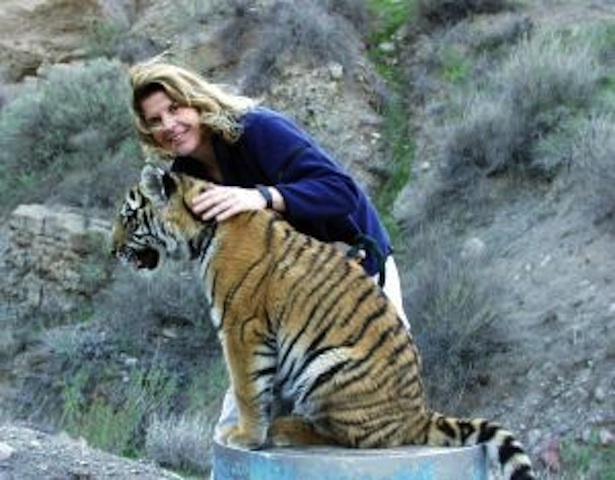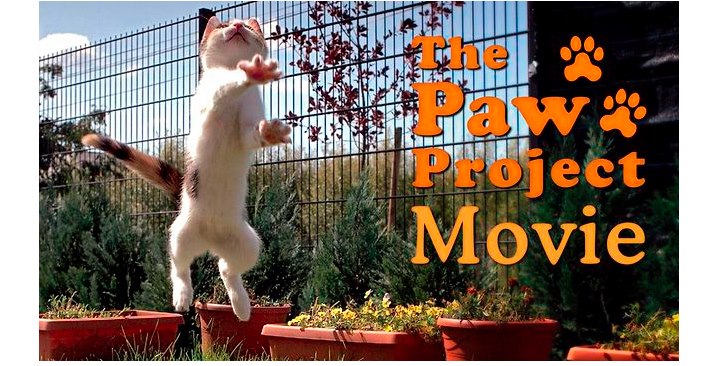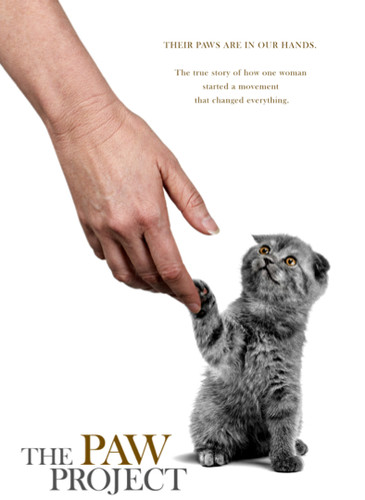
Dr. Jennifer Conrad, veterinarian and founder of The Paw Project: ‘Declawing is not at all declawing—it’s actually de-knuckling. …it is really an amputation. It is incredibly painful, and it does no good for the patient.’
If you’re considering getting your cat declawed, I have one word for you: Don’t.
If you’re wondering what’s behind this stern, succinct admonition, I have one more word for you: Amputation.
To bridge the gap in more loquacious fashion between that first one word and the second, we introduce Dr. Jennifer Conrad, a veterinarian and the founder of The Paw Project, a Santa Monica nonprofit organization that seeks to educate the public about the perils of feline declawing, and to end the practice of the declaw surgery.
In a June 26 interview with Dr. Conrad on Talking Animals, I began with the fundamental question…What, exactly, is declawing?
“Declawing,” she answered, “is not at all declawing—it’s actually de-knuckling. If it were just the claw, it might not be so horrible. But because it’s actually the entire knuckle, the last bone in the cat’s toe, it is really an amputation. It is incredibly painful, and it does no good for the patient.”
Anti-Declaw Public Service Announcement from The Paw Project. Declawing is not a nail trim. It is the amputation of the ends of a cat’s toes. For more information about the effects of declawing and humane alternatives, go to www.pawproject.org.
In terms of addressing the misconceptions that tend to obfuscate the declaw issue, Conrad’s comment represents only the tip of the, uh, toenail.
Indeed, in an unfortunate instance of antics with semantics, for many people the notion of “declawing” amounts to not much more than what I do when I sit at the end of the bed, and trim my toenails. Those people are suitably horrified (and should be) to learn “declaw” really is a grim misnomer for “amputation.”
“It is 10 different amputations, or more, depending on if you have a polydactyl cat,” Dr. Conrad explained. “Basically, the last knuckle in a cat’s paw. So if you were to look at your own hand, that whole entire last joint comes off. They do it with a guillotine blade, a scalpel blade, or a laser. It doesn’t seem to matter which one they do it with—in double-blind studies, all the cats do about the same: they are permanently maimed.”
Conrad has been tirelessly beating the anti-declaw drum for well over a dozen years, and despite running up against formidable foes—from that sweeping misimpression of “declaw” that touches even the most well-meaning cat owner, to veterinary trade organizations that don’t take kindly to Conrad’s efforts to put the kibosh on what, for many vets, is a substantial money maker—she has made significant inroads.
Now, those inroads are chronicled–and a great number of additional significant inroads are likely to result—with the arrival of “The Paw Project,” a 58-minute multifaceted documentary that chronicles Conrad’s work over the last decade-plus.
Loosely speaking, the film is divided into three segments—the first examining Conrad’s efforts caring for captive big cats and doing reparative surgery on numerous ones who’ve been crippled by the declaw procedure.
The second segment spotlights the parallel but broader perils of declawing house cats, laced with comments from veterinarians who’ve long been opposed to the declaw procedure, from those I’d call reformed vets who previously had recommended or performed the declaw surgery and now stand vehemently against it, and—via YouTube clips—veterinarians and leaders of veterinary organizations speaking about what they consider the virtues of declawing cats.
From there, “The Paw Project” shifts gear, widens out and becomes a political thriller of sorts, tracking how West Hollywood passed a pioneering ban on declawing cats, which some major veterinary organization responded to by getting a law passed preventing other cities from imposing similar bans—but leaving a loophole, and a window, for other cities to follow West Hollywood’s lead before the new law boxed them out. Ticking clock, race against time, high drama, suspense—these are elements not often found in an animal-oriented documentary.
A Paw Project PSA submitted for the competition by rrdixon13. Posted at YouTube.
Clearly, this is a movie that was fashioned with great care, skill and passion, a flick that bespeaks such precision and wise gambits that it seems too glib, maybe even too inaccurate, to use the word “flick.”
“When I first started the film, it was because I’d started repairing the paws on these big cats,” Conrad recalled. “It was remarkable to watch them hobbled before the surgery where we repair their paws, and to walk afterwards.
“And I wanted to document this, because I didn’t want to have my own bias in it. I wanted people to be able to tell me whether they saw what I saw. So that’s how it began.
“Then as I started filming it, I had more and more people come up to me and say, ‘Hey, let me film this for you, let me film that for you.’ And by around 2002 or 2003, we had started collecting a lot of footage.
“In 2002, we approached the city of West Hollywood about banning declawing, and when that final vote came up, there were 11 television channels there to televise their decision about whether they were going to ban declawing. And that’s when I knew that there was so much public interest in this, I decided to make a documentary.”
Dr. Jenny Conrad of the Paw Project speaks against cat declaw at Santa Monica City Council. The first reading passed and will soon be law.
The film serves as a way to repeat important messages Conrad has been uttering for years, but with much greater amplification—and, of course, the visual storytelling made possible by a cinematic enterprise. In this case, perhaps more than most—given the high-octane educational value–a picture truly is worth a thousand words.
“I think so,” she agreed, “and I also think it’s an interesting story to see how things twisted around, and how fate took a hand in making sure the cats would be protected.”
How so?
“I think when we won in West Hollywood, as you know, the city of West Hollywood gets sued by the veterinary corporations, and because they sued us, other cities began to become interested in what declawing is.
“So it kind of opened the door for me and The Paw Project and all the volunteers of The Paw Project—because there are many of them—to talk to each of these cities about what really is happening with declawing. Once they learned what it really is, they wanted to ban it.
Jackson Galaxy, cat behaviorist and star of Animal Planet’s My Cat from Hell, introduces Dr. Jennifer Conrad’s documentary, The Paw Project
The saga that unspools in “The Paw Project” is swirling with robust ironies; not least the one wherein the victory in West Hollywood triggers a tizzy amidst the veterinary power brokers and purse string jockeys.
“What happened was when we won the city of West Hollywood,” she said “we were sued by the California Veterinary Medical Association, which is a trade organization that protects the bottom line of veterinarians. They lost, ultimately, when the Supreme Court declined to hear the case. Then, what they did is went to the California State Legislature and they made a law that no city could ban declawing ever again.
“But that law had a loophole, in that it said that after January 1, 2010 no city could ban declawing ever again. Well, we had a little bit of time. We went from city to city to city, begging them, ‘Please realize we only have a little bit of time. And if you think declawing is disgusting, and you want it banned in your city, you cannot wait.’
“And what was amazing about that is how many legislators realized that they thought it was disgusting to declaw, they wanted it banned, and they put it on top of the agenda. So immediately, in cities as big as Los Angeles and San Francisco and Berkeley and Santa Monica, it became a very important, urgent issue.
“Which I think surprised the CVMA, because they were thinking their law was going to protect all the declawing vets in the state, except in West Hollywood…
“When West Hollywood passed the ban, there were only 35,000 people affected. After the CVMA made that law, five million-plus people could no longer declaw their cats.”
http://www.youtube.com/watch?v=vlEQitcpeEE
Official trailer for The Paw Project, a one hour documentary that chronicles the David and Goliath story of a tiny grassroots movement taking on big veterinary corporations in an effort to ban the declawing of cats. Declawing is an amputation of toe bones, it’s not a fancy manicure. For more information, visit www.pawproject.org.
As this tale plays out on the screen, it’s as gripping as any fictional story playing out on any sized screen—will the jewel thieves get away with the heist, will the serial killer score another kill before swarms of cops close in, will the bomb squad defuse the ticking device in time, and so on.
And “The Paw Project” holds its share of surprises, too—at one point, Conrad herself expresses surprise when a city as major and complex as Los Angeles passed the declaw ban. In our Talking Animals chat, I’ve barely mentioned this when she pounces: “Los Angeles voted unanimously to pass a ban,” she said.
“That’s pretty amazing because Los Angeles is a very, very varied city—the interests are all over the place in Los Angeles. For them to pass a ban unanimously meant that they looked at what declawing is, and wanted it to stop.”
The other California cities who’ve banned the declaw surgery through Conrad’s efforts are Burbank, San Francisco, Culver City, Beverly Hills, Berkeley, Santa Monica and, of course, West Hollywood. It’s also, by the way, illegal in more than 30 countries, including Australia, India, Spain and the UK.
Although Conrad is, in effect, the filmmaker, “The Paw Project” is even-handed in its examination of the declaw issue (I didn’t want to have my own bias in it…), including that looking at the veterinarians who perform the declaw surgery is not overtly framed as a financial matter.
A PSA for the Paw Project submitted by the SCUCI art class.
But one doesn’t have to be a cynic to observe that the procedure appears to be such a reliable, substantial money maker, this seems like an essential reason it’s done as often as it is. Or is that too cynical?
“Well, I think it boils down to that,” Conrad said. “Vets will often say ‘I only recommend declaw to protect human health—[for example] I’m afraid that person with HIV will get scratched by a cat.’
“But what’s so interesting about that is the CDC, NIH, U.S. Public Health Service, etc., etc., etc. all say declawing is not advised for the cats of those living with HIV/AIDS. So I would think the CDC would know better than veterinarians on matters of human health.
“The other reason that veterinarians often give for why they declaw cats is they’re afraid the cat will lose its home if they don’t declaw it. And while that sounds reasonable, all you have to do is look at what percentage of cats are losing their homes from being declawed, and you’ll see it’s actually 2 to 1, almost, because of the behavioral problems that happened because the cat was declawed.
“So it’s not helping the cats in any way, it doesn’t help human health, it does nothing—except for give a veterinarian a certain amount of income.”
In her answer, Conrad alludes to yet another of the robust ironies orbiting around Planet Declaw: The surgery is often performed, ostensibly, to make things better for that cat and the people who live with that cat.
Yet, after the procedure, the cat’s paws often are so tender that when they use the litter box, it’s really painful to dig in the sand—so they stop using the box. Strike 1. Also, post-surgery, the cat has obviously lost its claws, and therefore its primary ability to defend itself, and even to function in normal cat ways day-to-day. So the cat starts biting. Strike 2.
Sadly, in this game, you typically don’t get three strikes. With just two strikes, the cat is out, relinquished (or returned) to a shelter, where now the cat’s bio includes “refuses to use litter box” and “regularly bites.” Any guess how readily that cat will be adopted?
One of the folks interviewed in the film, a woman named Erica Willhite, says at one point that she’s come to the conclusion that having her cat declawed was “the worst decision I’ve ever made in my life.”
At another point, she asks what may represent the $64,000 question: “Why don’t vets mention options?”
Well, I think we’ve established that for a sizable squad of declaw-performing vets, there’s a significant financial disincentive to mentioning options.
But options do exist, including, Conrad explained, trimming the cat’s nails (she says you can reward cats with a treat until they understand the trimming process to be a good thing) or having a vet do it, not unlike the way people take their dog there to have its nails trimmed. Or a groomer can do it.
Scratching posts are another viable option, provided serious effort is placed into determining what sort of post (carpet, wood, etc.) will be most effective for your cat, and ditto the location you decide on for where that post will sit. Yet another option is the use of Soft Paws, small vinyl sheaths that fit over the cat’s nails and can be used until the cat can be trained to use the appropriate scratching surface.
This movie is clearly brimming with information and drama, too—there are no special effects, but it’s loaded with special impact.
So, you may wonder, how does one see “The Paw Project”? Well, a limited theatrical release is slated for the Fall in New York, Los Angeles and Chicago. Communities can request screenings of the film at local theaters through www.TUGG.com.
Conrad has scheduled some dates of a screening/speaking tour—Santa Monica in July, Portland in August, and so on. You can track info at The Paw Project website, http://www.pawproject.org, or the film site: http://www.pawprojectmovie.com
People who should see this documentary include those who live with cats and those who’ve ever loved cats. But I view the potential audience as being a good deal broader, including those who care about animals, about animal welfare, and about how legislation at various levels can be implemented to protect animals, and others.
I’m reminded of something Dr. Conrad said in addressing one of the ironies that marks this saga—that if the California Veterinary Medical Assn. hadn’t gone so bonkers about the West Hollywood declaw ban and passed the law preventing cities from passing more bans, there wouldn’t be bans in seven other California cities:
“It’s sort of a twist of fate,” she observed, “that I think makes the movie more than just an animal movie, and more than just a sad movie about declawing. It makes it a movie about what can be done with a lot of perseverance.”
Listen to the entire Talking Animals interview with Dr. Conrad here.




